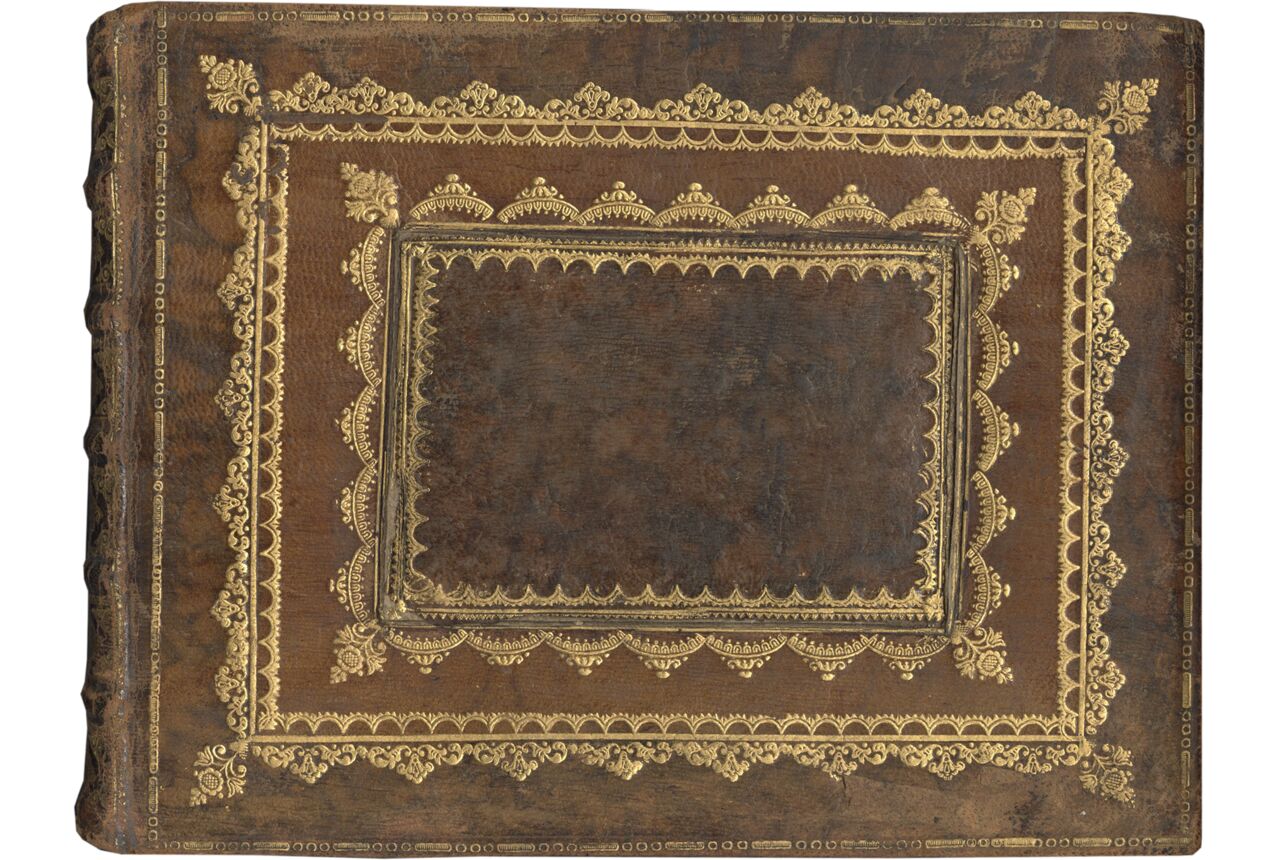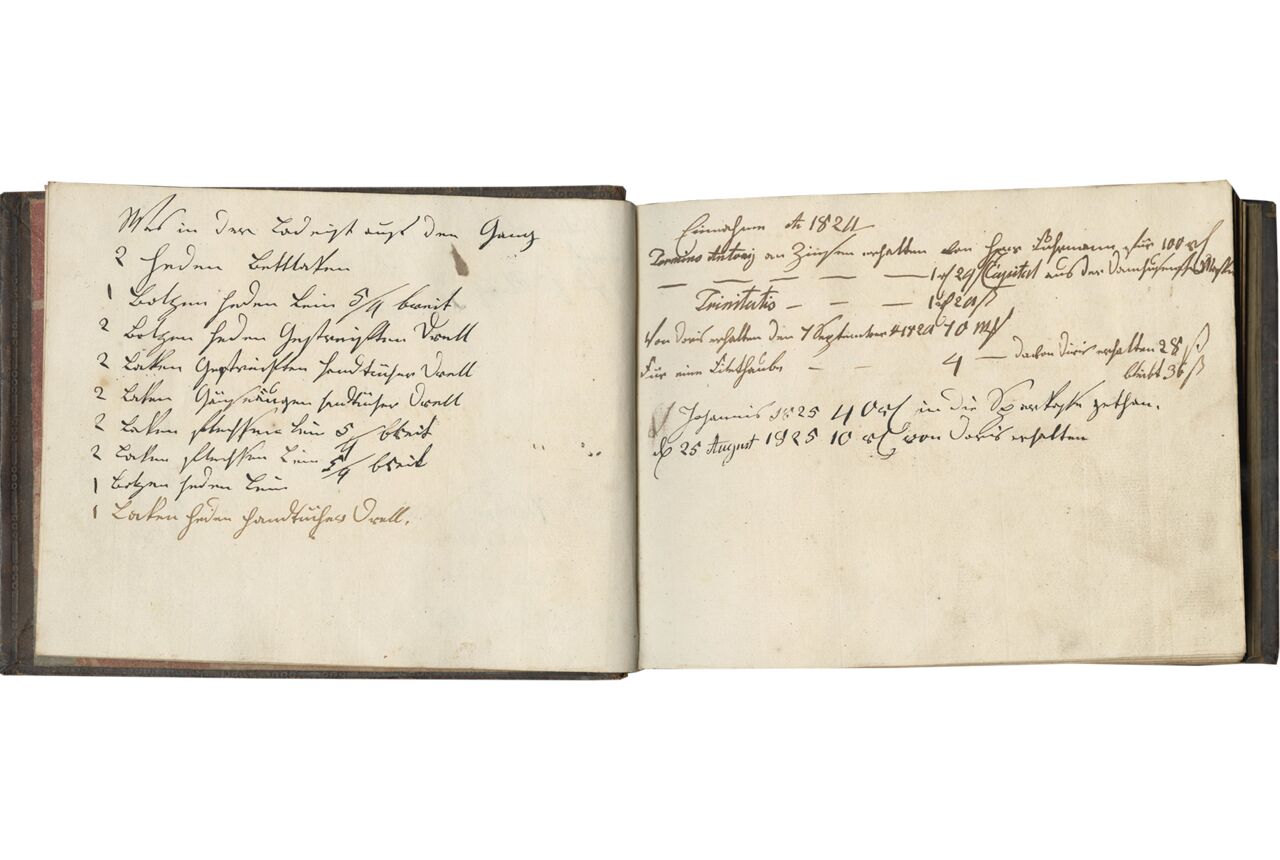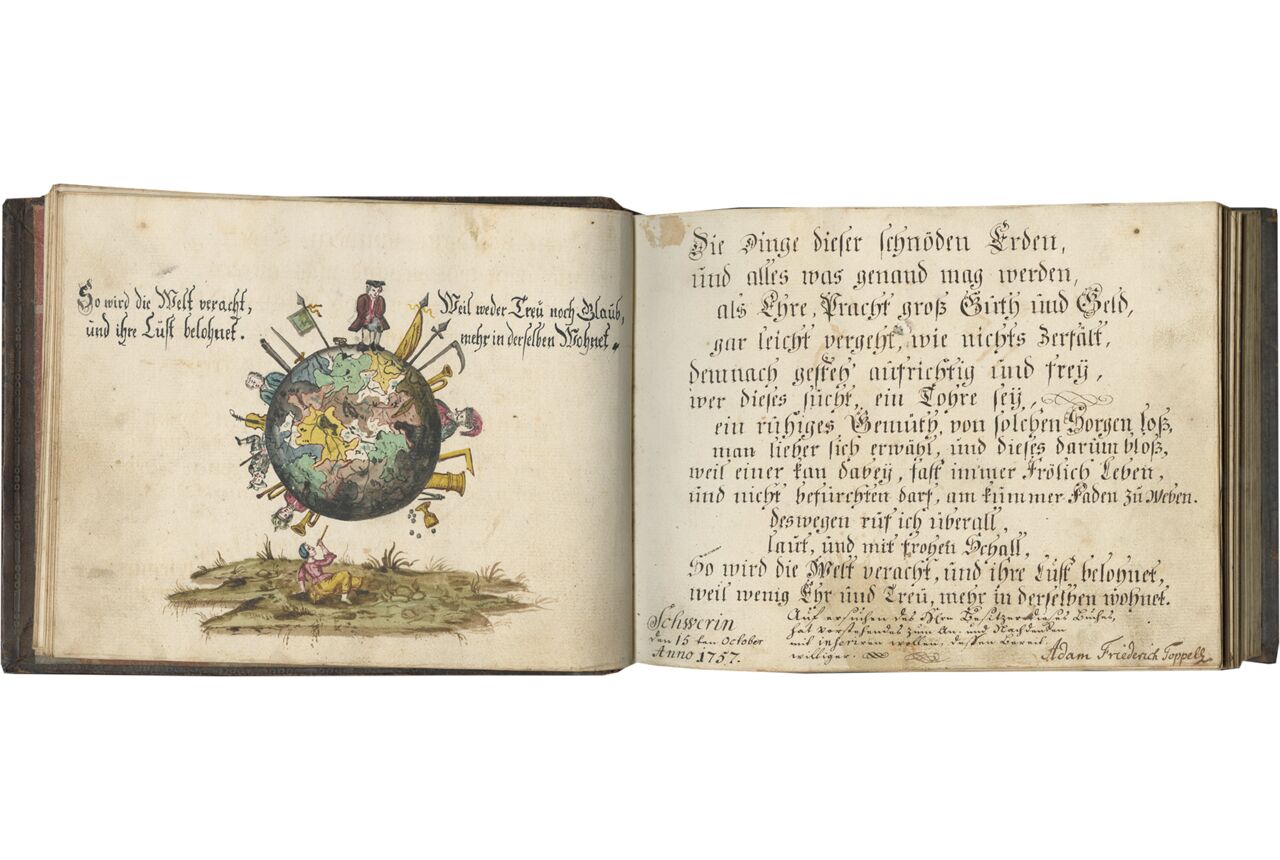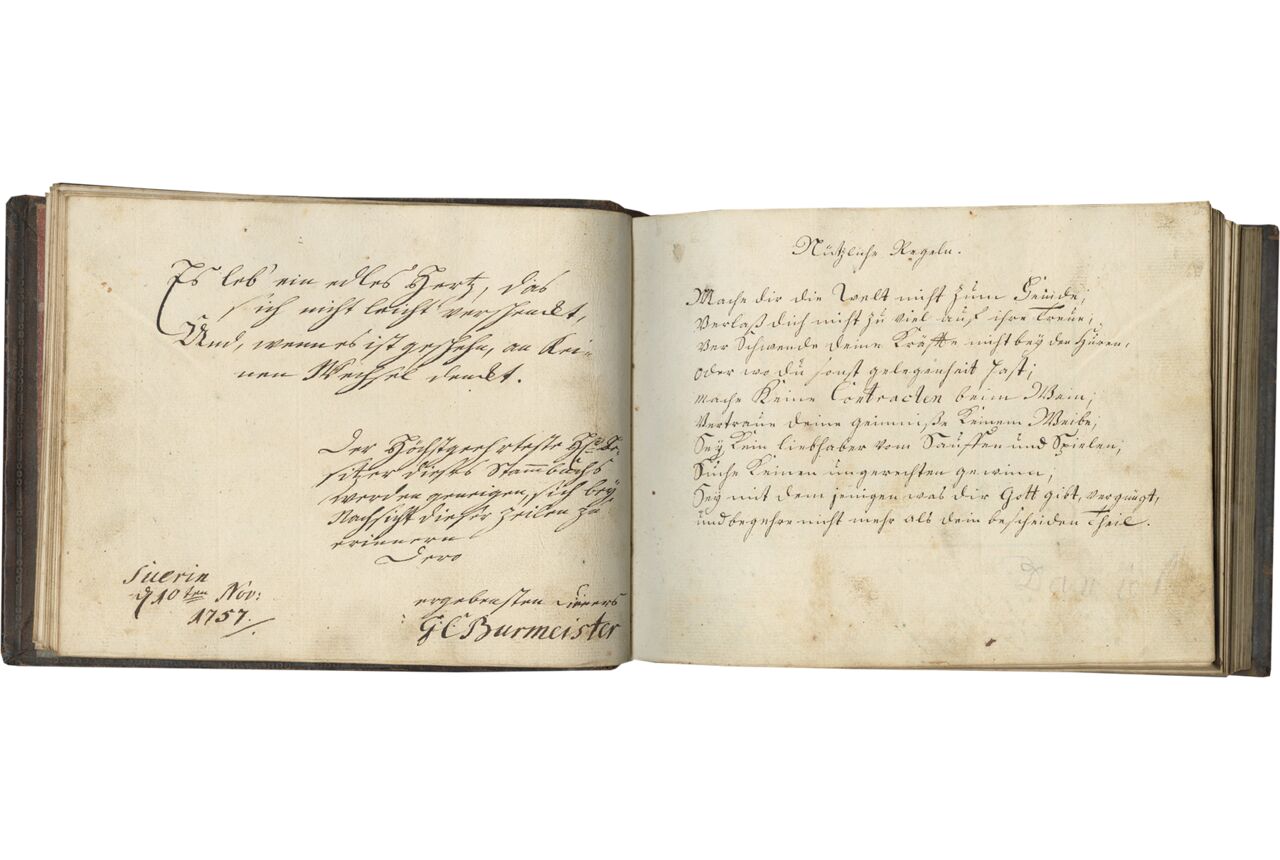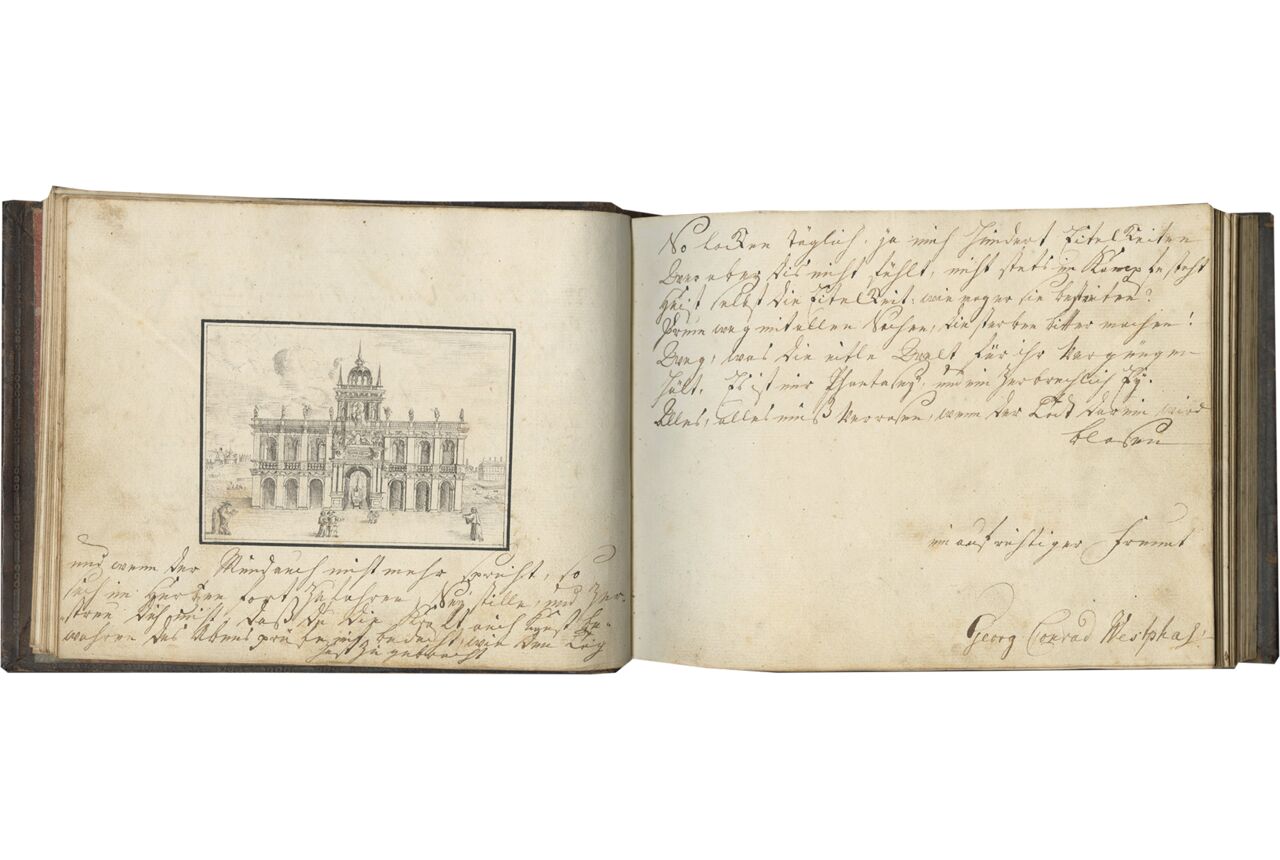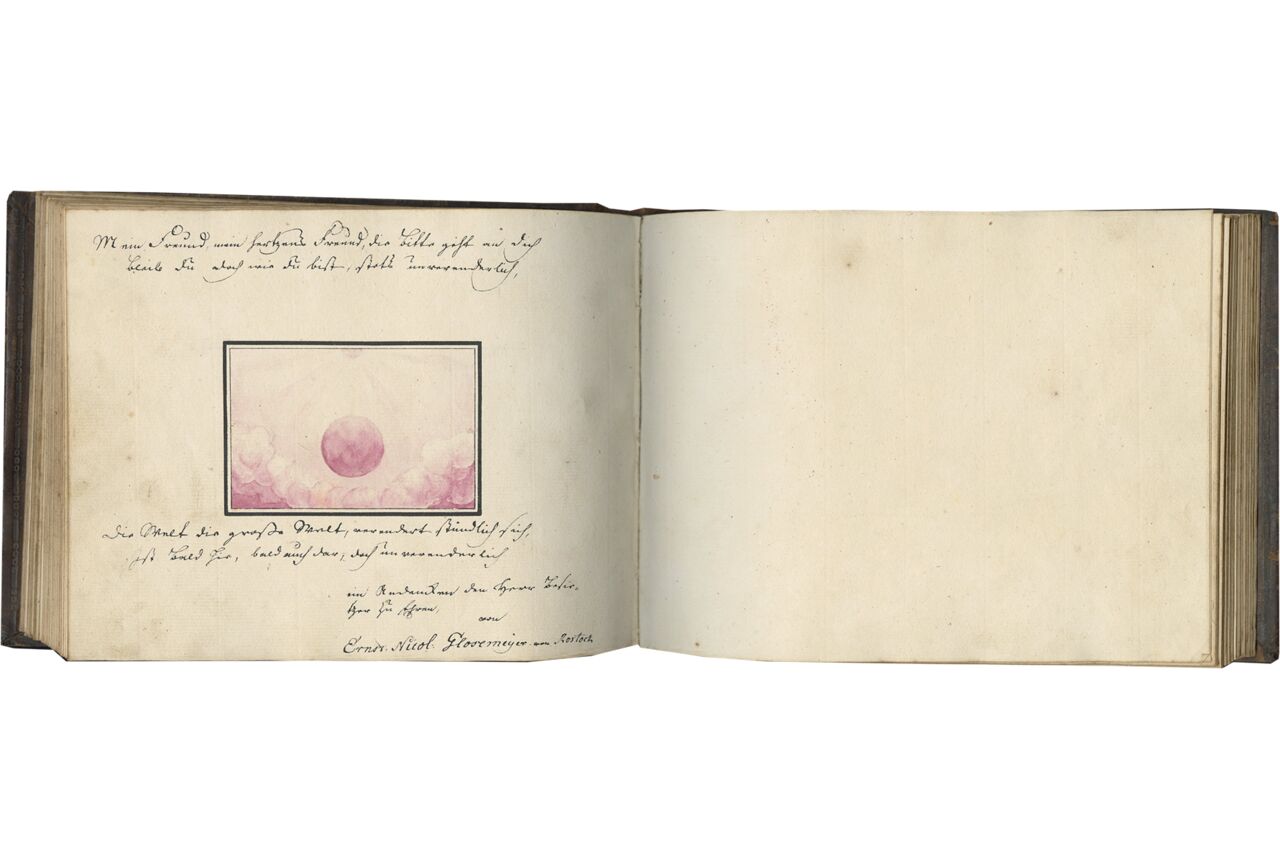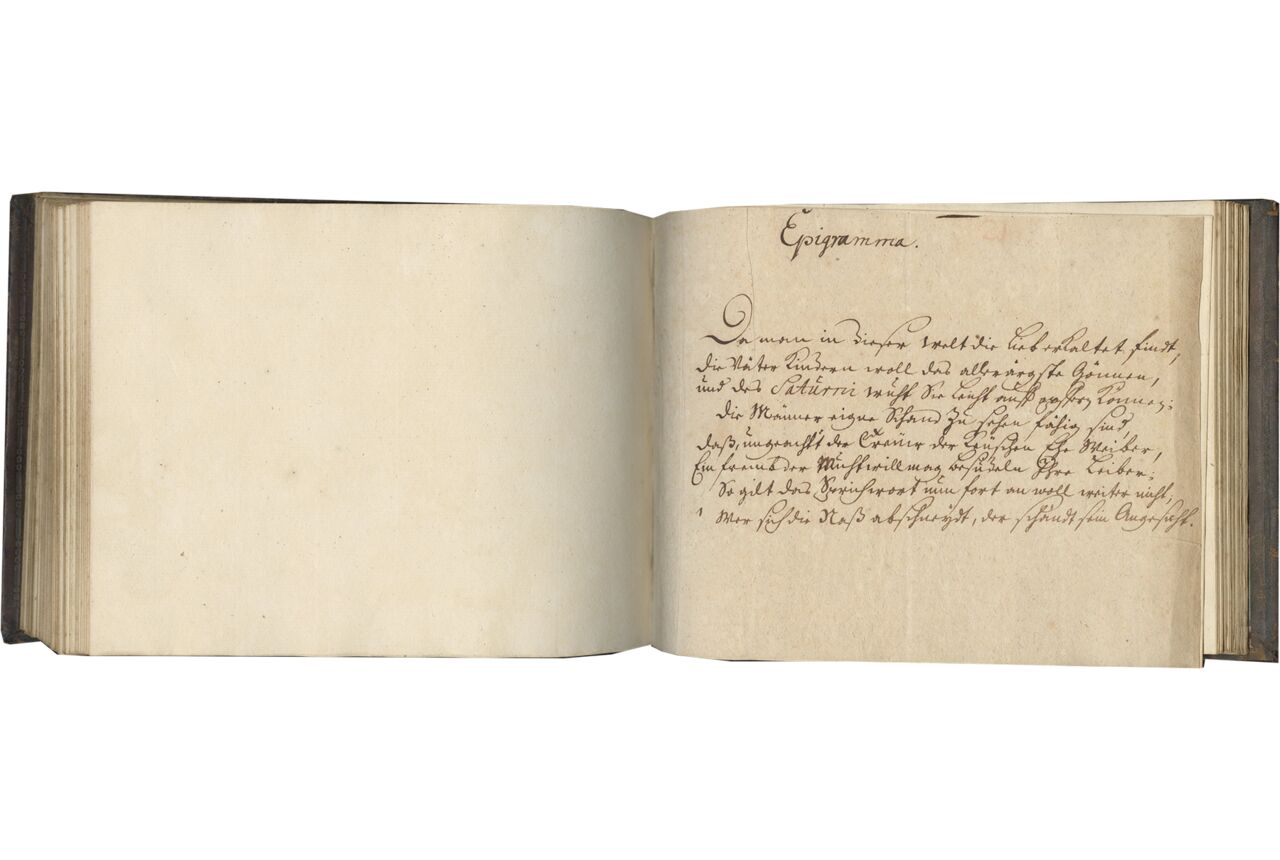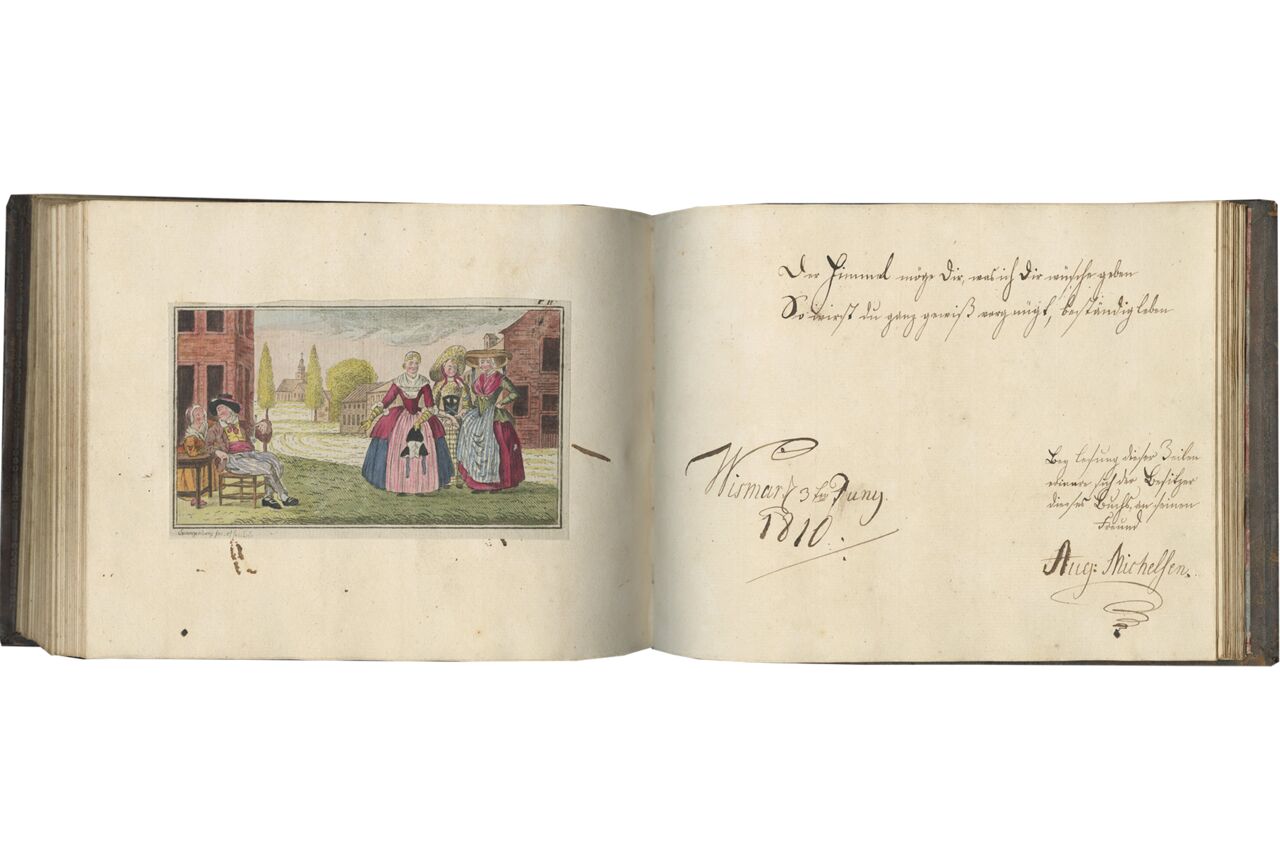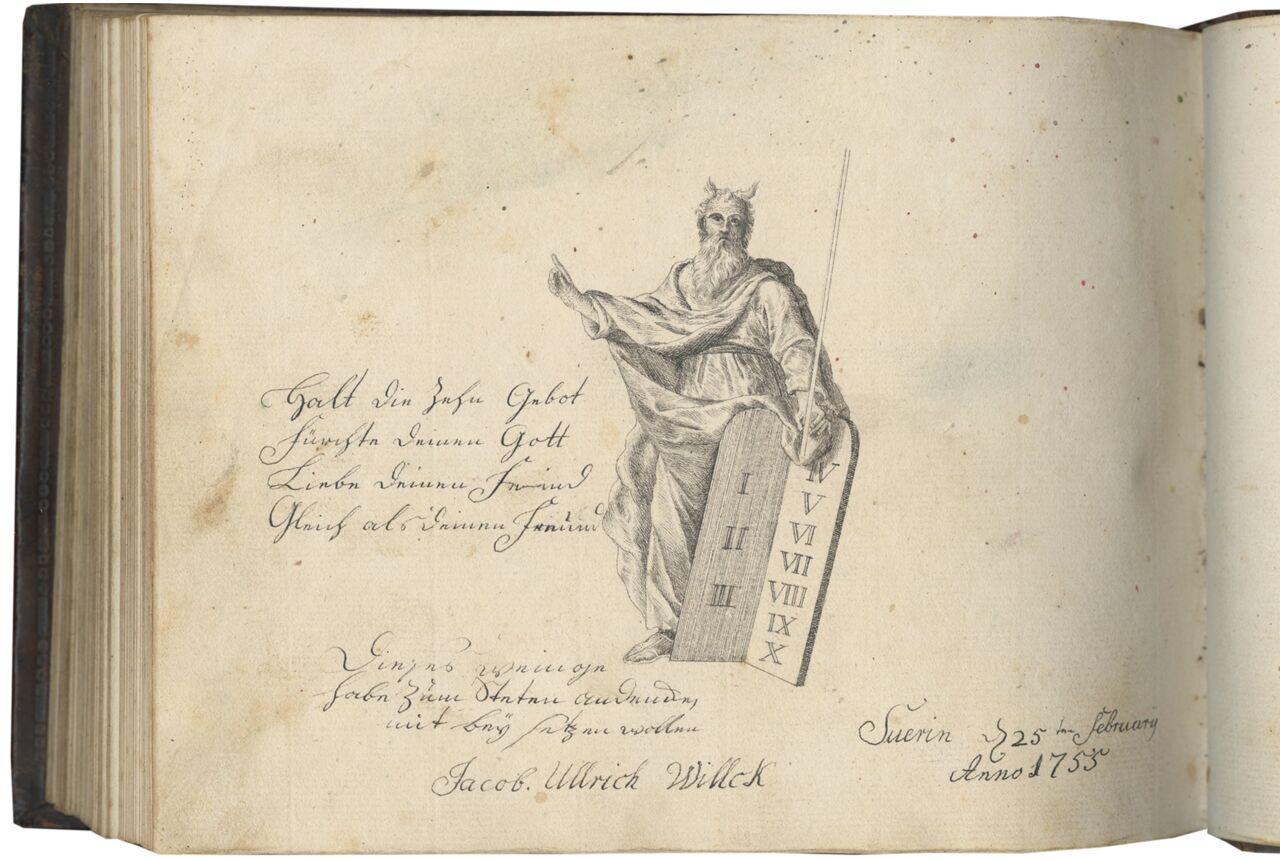i + 132 + i folios on paper, modern foliation in pencil, 1-132, FOUR WATERCOLORS, TWO PEN AND INK DRAWINGS, TWO COPPER ENGRAVINGS ENHANCED IN WATERCOLOR, some minor stains, in overall excellent condition. In its original binding with covers decorated with three separate leather inlays: in the center a rectangle in brown morocco, surrounded by a frame in brown calf, surrounded by a frame in mottled calf, each leather inlay framed by a fine gold-tooled border with foliage, cusped lines, circles, fillets and corner fleurons, spine with five raised bands, richly gold-tooled with foliage and arabesque ornaments, marbled endpapers and pastedowns, edges gilt, leather worn, but in overall excellent condition. Dimensions 149 x 192 mm.
This Album amicorum includes two very fine pen and ink drawings, four watercolors and two engravings painted by hand, partly inspired by travel. The subjects range from pastoral scenes with shepherds, to scenes from towns in Turkey and Italy, to the Bible (Moses and the Ten Commandments). It provides interesting insight into the eighteenth-century social history in Mecklenburg, the northeastern German state, with most entries made in Schwerin, the home of the dukes and grand dukes of Mecklenburg.
Provenance
1. The album was made for an unidentified citizen of Schwerin in Mecklenburg, northeastern Germany, in 1755-1757, with a few later entries made nearby in Wismar and Rostock, on the coast of the Baltic Sea, in 1810. The House of Mecklenburg is one of the oldest royal houses in Europe. The owner of our manuscript could be an aristocrat in the circle of the German princely family.
Illustration
f. 12v, Watercolor representing a globe surrounded by people in different costumes, instruments of music, weapons, battle flags, instruments of geometry, columns, a chalice; below on the ground lies the poet (?), and the following lines flank the globe: “So wird die Welt veracht, und ihre Lüst belohnet. Weil weder Treü noch Glaüb, mehr in derselben Wohnet” (Thus the world is despised, and its lust rewarded. Because neither faithfulness nor faith dwells in it any longer). The watercolor is by Adam Friederich Toppell who signed in 1757 on the facing page at the end of a long poem. The poem ends slightly differently from the lines accompanying the illustration: “So wird die Welt veracht, und ihre Lüst belohnet, weil wenig Ehr und Treü, mehr in derselben Wohnet” (Thus the world is despised, and its lust rewarded, because little honor and loyalty dwell in it anymore);
f. 18v, Very fine pen and ink drawing by Georg Conrad Westphal representing an Italian palazzo, signed on the facing page;
f. 58v, Copper engraving enhanced in watercolor representing eight servants around a table engaged in different activities (perhaps those of an inn or large household?), pasted onto the page, the accompanying entry on the facing page is signed by C. Schweitzer in 1756;
f. 62v, Watercolor in monochrome pink tones by Ernst Nicol. Glosemeyer representing a globe in clouds, made in Rostock;
f. 64v, Fine watercolor by Johann Gotthelf Lehmann representing a Turkish town, accompanied on the facing page by an amusing poem “Die Türcken haben schöne Töchter...,” made in Schwerin in 1755;
f. 76v, Watercolor by Jean David Suel representing a pastoral scene at a watering place, in which a shepherd leans in to kiss a shepherdess in the foreground of the image, while two shepherds discuss in the background, signed on the facing page, made in Schwerin in 1755;
f. 107v, Copper engraving enhanced in watercolor representing peasants in traditional costumes, inscribed by hand below the image “Spangenberg feci et sculpsi,” pasted onto the page, the accompanying entry on the facing page is signed by August Michelsen in Wismar in 1810;
f. 116v, Very fine pen and ink drawing by Jacob Ulrich Willck representing Moses with tablets of the ten commandments, made in Schwerin in 1755, undoubtedly copied from an engraving such as those illustrating the book of Exodus in a Bible.
Text
Other entries, mainly poems, are by Cadel Schna...(?) (verso of the front flyleaf), August Michelsen (f. 1, cf. the entry on 107v-108 described above; both entries dated in Wismar in 1810), unsigned (ff. 1v-2), G. C. Burmeister (f. 17v), unsigned (f. 18), Peter Heldi (f. 69v), Christian Gottlieb Müller (f. 70), and an unsigned entry with the poem “Epigramma” written on different paper and inserted into the volume (f. 97).
Although the entries in this album do not appear to reveal the identity of its owner, it is tempting to see him in relation to the ducal family of Mecklenburg-Strelitz, whose presence in Schwerin was especially prominent at the time of making our manuscript. The marriages of the ducal princesses linked the house to some of the most powerful states in Europe: Princess Charlotte married King George III of Great Britain in 1761 (she was the grandmother of Queen Victoria), Princess Louise married King Friedrich Wilhelm III of Prussia in 1793 and Princess Frederica married King Ernst August of Hanover in 1815.
Although all entries were made in Mecklenburg, some of the illustrations, especially the Italian palazzo (f. 18v), the Turkish town (f. 64v) and the globe (f. 12v) suggest that they were inspired by travel. Furthermore, Toppell’s painting on f. 12v, showing a globe surrounded by weapons (in addition to various cultural citations), might be in reference to military careers. The marriages, which introduced the Mecklenburg-Strelitz ducal family into the kingdoms of Britain, Prussia and Hanover, enabled the princes and their circles to attain important military posts in the armies of their brothers-in-law. Further research is needed to identify the owner of our manuscript, and there are undoubtedly more clues in its text and images.
The album amicorum, or album of friends, is a booklet in which the owner collected entries made by their friends and relatives. The entries are typically poems, wishes, drawings and watercolors, signed with a date and location. The album amicorum was popular from the sixteenth until the nineteenth century. It was initially favored by men in aristocratic, bourgeois and university circles, and entries were collected from acquaintances met during travels and studies. All entries made in our manuscript appear to be by men. The album amicorum is central in modern transdisciplinary research studying texts, reception, and collecting in cultural and social contexts and the history of mentalities; see especially the comprehensive study by Werner Wilhelm Schnabel published in 2003.
Literature
Fechner, J.-U., ed. Stammbücher als kulturhistorische Quellen, Wolfenbütteler Forschungen 11, Munich, 1981.
Keil, R. and R. Die deutschen Stammbücher des sechzehnten bis neunzehnten Jahrhunderts. Ernst und Scherz, Weisheit und Schwank in Original-Mittheilungen zur deutschen Kultur-Geschichte, Berlin, 1893 (reprint Hildesheim, 1975).
Klose, W. “Stammbücher: eine kulturhistorische Betrachtung,” Bibliothek und Wissenschaft 16 (1982), pp. 41-67.
Kurras, L. Zu gutem Gedenken. Kulturhistorische Miniaturen aus Stammbüchern des Germanischen Nationalmuseums 1570-1770, Munich, 1987.
Lilienthal, M. Schediasma critico-literarium de philiothecis varioque earundum usu et abusu, vulgo von Stamm-Büchern, Königsberg, 1712; rev. Wittenberg, 1740 (repr. in Fechner, 1981, pp. 237-298). [the first study of Alba Amicorum].
Nickson, M.A.E. Early Autograph Albums in the British Museum, London, Trustees of the British Museum, 1970.
Rosenheim, M. The album amicorum, Oxford, 1910.
Schnabel, W. W. Das Stammbuch: Konstitution und Geschichte einer textsortenbezogenen Sammelform bis ins erste Drittel des 18. Jahrhunderts, Berlin, 2003.
Schünemann, H. “Stammbücher,” Schrifttumsberichte zur Genealogie und zu ihren Nachbargebieten 2 (1965), pp. 67-108.
Taegert, W. Edler Schatzholden Erinnerns: Bilder in Stammbüchern der Staatsbibliothek Bamberg aus vier Jahrhunderten, Bamberg, 1995.
Thomassen, K. (ed.). Alba amicorum. Vijf eeuwen vriendscap op papier gezet. Het album amicorum en het poëziealbum in de Nederlanden, Maarssen/The Hague, 1990.
Online Resources
Repertorium Alborum Amicorum:
https://raa.gf-franken.de/de/startseite.html
(our manuscript is not recorded)
TM 1119


